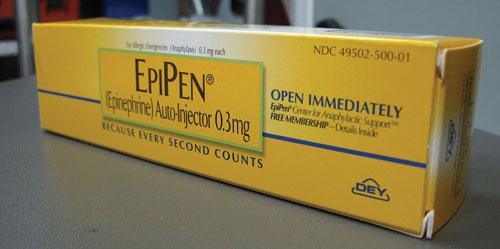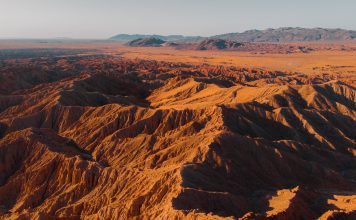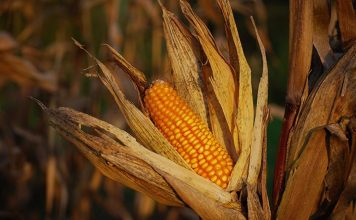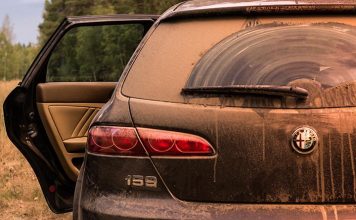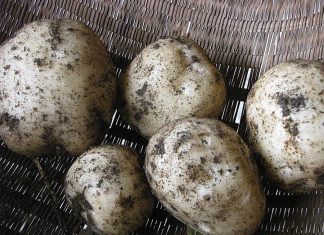| Issue #140 • March/April, 2013 |
Cuts and scrapes are the most likely wounds gardeners incur (hopefully, not on that green thumb of yours). In many cases, these could have been prevented by simply using hand protection. Start off your gardening efforts by obtaining a good pair of work gloves; most injuries will occur on your hands.
You can expect to be at risk for the following mishaps in the garden:

Typical abrasion
Minor cuts (scratches): These tears in the skin only penetrate the “epidermis” (superficial skin layer) and become infected on an infrequent basis in a healthy person.
Abrasions (scrapes): A portion of the epidermis has been scraped off, exposing the dermis. You probably have experienced plenty of these as a child.
Contusions (bruises): These result from blunt trauma and do not penetrate the skin at all. However, there is bleeding into the skin from blood vessels that have been disrupted by the impact.
All of the above minor injuries can be easily treated. Wash the wound anywhere that the epidermis has been violated. The use of an antiseptic such as Betadine (Povidone-iodine solution), honey, or triple antibiotic ointment, such as Neosporin or Bactroban, will be helpful to prevent infection. Ibuprofen and acetaminophen are useful over-the-counter drugs to treat minor pain.
Minor bleeding can be stopped with a wet styptic pencil, an item normally used for shaving cuts. The wound, if it broke the skin, should have a protective adhesive bandage (such as a Band-Aid) to prevent infection.
Applying pressure and ice wherever a bruise seems to be spreading will stop it from getting bigger. Bruises will change color over time from blackish-blue to brown to yellow. Bruises may be gravity-dependent and may descend slightly as time goes on.
The Liquid Skin bandage is an excellent way to cover a minor injury with some advantages over a regular bandage. Apply it once to the cut or scrape; it dries within a minute or so and seals the wound. It also stops minor bleeding and won’t peel off during baths. There are various brands (Band-Aid Liquid Bandage, New Skin, Curad, 3M Nexcare No-Sting liquid bandage) and many come as a convenient spray. These injuries will heal over the next 7-10 days, dependent on the amount of skin area affected.
If you have one of the minor injuries mentioned above, why not consider natural remedies? Here’s an alternative process to deal with these issues:
1) Stop minor bleeding with herbal blood clotting agents and compress the area with gauze. Substances that clot blood are called “hemostatic” agents. These include:
- Essential oils geranium, helichrysum, lavender, cypress, myrrh, or hyssop.
- Medicinal herbs yarrow tincture, or directly apply cayenne pepper powder or cinnamon powder.
2) After minor bleeding is stopped, the wound should be cleaned with an herbal antiseptic. Mix a few drops of oil with sterile water and wash out the wound thoroughly. Essential oils with antiseptic properties include:
- Lavender
- Tea tree
- Rosemary
- Eucalyptus
- Peppermint
Apply herbal antiseptic to the wound in a 50/50 mix with carrier oils such as olive or coconut oil. Other natural antiseptics include garlic, raw unprocessed honey, echinacea, witch hazel, and St. John’s wort.
3) If needed, use natural pain relievers such as:
- Geranium oil
- Helichrysum oil
- Ginger oil
- Rosemary oil
- Oregano oil
Apply 2-4 drops of a 50/50 dilution around the wound’s edges.
4) Dress the wound using clean gauze. Do not wrap too tightly.
5) Twice daily, change the dressing, reapply antiseptic, and observe for infection until healed.
An infected wound will appear red, swollen, and warm to the touch. In these cases, the use of antibiotics such as Amoxicillin 500 mg orally for 7-10 days is curative.

Second degree burn (Photo: CJR80)
Sunburns
Another common medical problem a gardener will be at risk for is sunburn. The severity of the burn injury depends on the percentage of the total body surface that is burned, and on the degree (depth) of the burn injury.
First degree burns are very common, such as simple sunburn. The injury will appear red, warm, and dry, and will be painful to the touch. These burns frequently affect large areas of the torso; immersion in a cool bath is a good idea or, at least, running cool water over the injury.
Placing a cool moist cloth or Spenco 2nd Skin on the area will give some relief, as will common anti-inflammatory medicines such as Ibuprofen. Aloe vera or zinc oxide cream is also an effective treatment.
Usually, the discomfort improves after 24 hours or so, as only the superficial skin layer, the epidermis, is affected. Avoid tight clothing and try to wear light fabrics, such as cotton.
Second degree burns are deeper, going partially through the skin, and will be moist and have blisters with reddened bases. The area will have a tendency to weep clear or whitish fluid. The area will appear slightly swollen, so remove rings and bracelets.
To treat second degree burns:
- Run cool water over the injury for 10-15 minutes (avoid ice).
- Apply moist skin dressings such as Spenco 2nd Skin.
- Give oral pain relief such as Ibuprofen.
- Apply anesthetic ointment such as Benzocaine.
- Use silver sulfadiazine (Silvadene) creams to help prevent infection.
- Consider antibiotic ointment if slow to heal.
- Lance only large blisters.
- Avoid removing burned skin.
I had a significant second degree burn as a child (they called it “sun poisoning” back then) and my little brother thought it was a good idea to peel off some skin. He ended up with a 10-inch x 2-inch strip of skin in his hands. Do not peel off skin from a second degree burn.
There is a deeper degree of burn known as “third degree.” This is a major injury that is highly unlikely from simple exposure to the sun.
Again, an ounce of prevention is worth a pound of cure. To avoid getting burned:
- Do not sunbathe (a tan is not healthy).
- Avoid peak sun hours (11 a.m. to 4 p.m.).
- Wear long pants and sleeves, hats, and sunglasses.
- Spend some time in the shade.
If you cannot avoid extended exposure to sunlight, be certain to apply a sunblock. It should be applied prior to going outside and frequently throughout the day. Even water resistant/proof sunscreens should be reapplied every 1 to 2 hours. Most people fail to put enough on their skin; be generous in your application.
A sunblock and a sunscreen are not the same thing. Sunblocks contain tiny particles that “block” and reflect UV light. A sunscreen contains substances that absorb UV light, thus preventing it from penetrating the skin. Many commercial products contain both.
The SPF (Sun Protection Factor) rating system was developed in 1962 to measure the capacity of a product to block UV radiation. It measures the length of time your skin will be protected from burning.
A SPF (sun protection factor) of at least 15 is recommended. It takes about 20 minutes without sunscreen for your skin to turn red. A product that is SPF 15 should delay burning by a factor of 15, or about 5 hours or so. Higher SPF ratings give more protection, and might be beneficial to those with fair skin.

Those experiencing an anaphylactic reaction will require treatment with epinephrine. An EpiPen has a pre-measured dose cartridge for quick delivery.
Insect bites
There so many insects, both beneficial and harmful, in the garden that you can expect to regularly get bitten by them. Insect bites usually cause pain with local redness, itching, and swelling but are rarely life-threatening.
For most victims, the offender will be a bee, wasp, or hornet. A bee will leave its stinger in the victim, but wasps take their stingers with them and can sting again. Even though you won’t get stung again by the same bee, they send out a scent that informs nearby bees that an attack is underway. As such, you should leave the area whether the culprit was a bee, wasp, or hornet.
The best way to reduce any reaction to bee venom is to remove the bee stinger as quickly as possible. Pull it out with tweezers or, if possible, your fingers. The longer bee stingers are allowed to remain in the body, the higher chance there is for a severe reaction.
Most bee and wasp stings heal with little or no treatment. For those who experience only local reactions, the following actions will be sufficient:
1. Clean the area thoroughly.
2. Remove the stinger if visible.
3. Place cold packs and anesthetic ointments to relieve discomfort and local swelling.
4. Control itching and redness with oral antihistamines such as Benadryl or Claritin.
5. Give acetaminophen or ibuprofen to reduce discomfort.
6. Apply antibiotic ointments to prevent infection.
Topical essential oils may be applied (after removing the stinger) with beneficial effect. Use Lavandin, helichrysum, tea tree, or peppermint oil, applying 1 or 2 drops to the affected area, 3 times a day. A baking soda paste (baking soda mixed with a small amount of water) may be useful when applied to a sting wound.
Although most of these injuries are relatively minor, there are quite a few people who are allergic to the toxins in the stings. Some are so allergic that they will have what is called an “anaphylactic reaction.” Instead of just local symptoms like rashes and itching, they will experience dizziness, difficulty breathing, and/or faintness. Severe swelling is seen in some, which can be life-threatening if it closes the person’s airways.
Those experiencing an anaphylactic reaction will require treatment with epinephrine as well as antihistamines. People who are aware that they are highly allergic to stings should carry antihistamines and epinephrine on their person whenever they go outside.
Epinephrine is available in a pre-measured dose cartridge known as the “EpiPen” (there is a pediatric version, as well). The EpiPen is a prescription medication, but few doctors would begrudge a request for one. Make sure to make them aware that you will be outside and may be exposed to possible causes of anaphylaxis. As a matter of fact, it may be wise to have several EpiPens in your possession if you have allergies.
Other medical issues for the gardener include spider bites, snake bites, mosquito-borne illness, and pathogens (disease-causing organisms) that reside in the soil. Next issue, we’ll explore these subjects.
Joe and Amy Alton are the authors of the #1 Amazon Best seller The Doom and Bloom Survival Medicine Handbook. They have more than 250 articles regarding medical preparedness on their website at www.doomandbloom.net.


